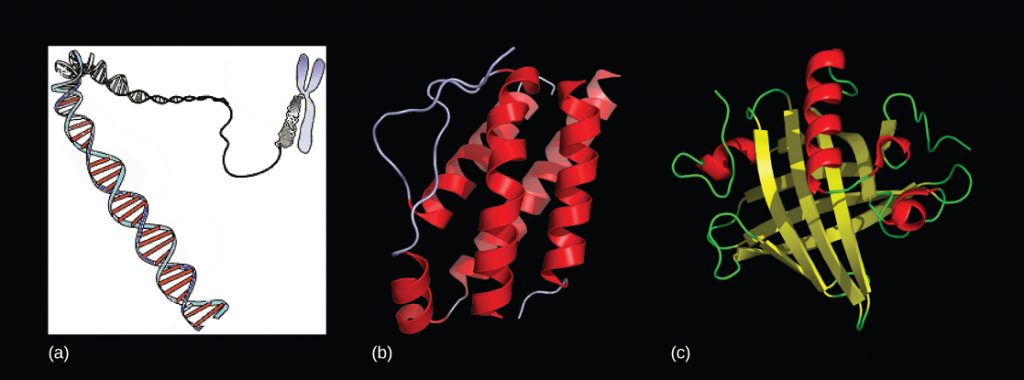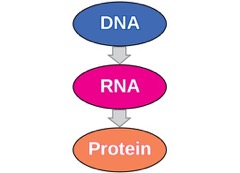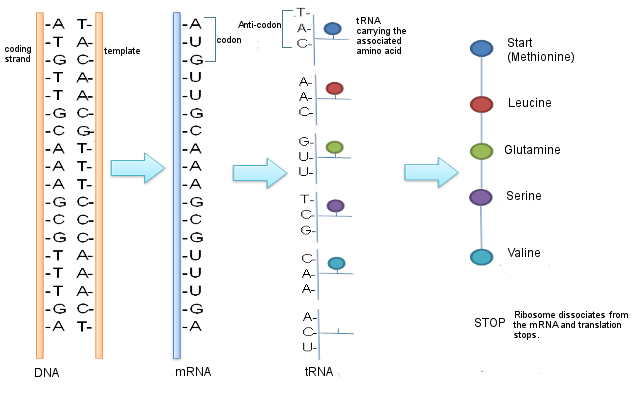49 Review of Protein Synthesis
In order to understand the potential effect of mutations, we must first recall how the information in DNA is used to produce a protein. Each protein is coded for by a gene, which is typically hundreds or thousands of base pairs in length. The information in the gene specifies the order in which the amino acids will be assembled into the protein. The order of the amino acids determines the protein’s shape, which determines its function.

The journey from gene to protein is complex and tightly controlled within each cell. It consists of two major steps: transcription and translation.Together, transcription and translation are known as gene expression.
Transcription
During the process of transcription, the information stored in a gene’s DNA is used as a blueprint to produce a similar molecule called RNA (ribonucleic acid) in the cell nucleus. Both RNA and DNA are made up of a chain of nucleotide bases, but they have slightly different chemical properties (Figure 2).
- Both RNA and DNA contain a 5-carbon sugar, but the sugar differs: it is deoxyribose in DNA and ribose in RNA (DNA stands for deoxyribonucleic acid; RNA stands for ribonucleic acid).
- DNA and RNA also differ in the nitrogenous bases they contain. DNA contains A, T, C, and G. RNA contains A, C, and G, but no thymine. Instead it contains a base called uracil (U).
- DNA is almost always double-stranded (a double helix), while RNA is typically single stranded.

The type of RNA that contains the information for making a protein is called messenger RNA (mRNA) because it carries the information, or message, from the DNA out of the nucleus into the cytoplasm. During transcription, this mRNA copy is made from a DNA molecule. This is possible because of the base-pairing rules: A with T (or U) and C with G. The hydrogen bonds connecting the base pairs in a DNA molecule are broken, and an enzyme creates a chain of RNA nucleotides that correspond to the DNA sequence.
In eukaryotes, transcription occurs in the nucleus (because that’s where the DNA is). In prokaryotes, transcription occurs in the cytoplasm because there is no nucleus.
RNA Processing
After prokaryotes produce an mRNA, it can be immediately translated since both processes occur in the cytoplasm. In fact, transcription and translation can occur at the same time – as an mRNA is being transcribed, it can also begin to be translated.
Eukaryotes require a more complex process since the mRNA must move from the nucleus to the cytoplasm. Additionally, eukaryotic mRNAs are typically modified in several different ways: portions of the mRNA that do not code for amino acids are removed (“spliced” out), and the 5′ and 3′ ends are modified to help with recognition and mRNA stability. After these modifications are made, the mature mRNA is transported to the cytoplasm.
Translation
Translation, the second step in getting from a gene to a protein, takes place in the cytoplasm. The mRNA interacts with a specialized complex called a ribosome, which “reads” the sequence of mRNA bases. In conjunction with a type of RNA called transfer RNA (tRNA), the protein is assembled according to the instructions in the mRNA molecule. Each sequence of three bases in the mRNA, called a codon, usually codes for one particular amino acid. Remember that amino acids are the building blocks of proteins. Protein assembly continues until the ribosome encounters a “stop” codon (a sequence of three bases that does not code for an amino acid).
Recall that ribosomes are located in two different places in eukaryotic cells: free-floating in the cytoplasm and attached to the rough endoplasmic reticulum. The final destination of the protein determines where it will be synthesized.

The flow of information from DNA to RNA to proteins is one of the fundamental principles of molecular biology. It is so important that it is sometimes called the “central dogma” (Figures 3 and 4).

References
Unless otherwise noted, images on this page are licensed under CC-BY 4.0 by OpenStax.
“What are proteins and what do they do?”by U.S. National Library of Medicineis in the Public Domain

